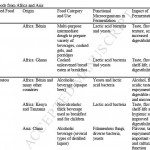- “All green chile derives its genetic base from the work of Fabian Garcia. We are at the center of the universe when it comes to chile because of Dr. Garcia.”
- Indian farmers move out of sugarcane, live to regret it.
- Freakonomists get Svalbard governance slightly wrong, but what the heck. Get it from the horse’s mouth.
- Adapting to climate change in Cuba through crop improvement.
- The Argentinian gauchos are running scared. And not just because of their pathetic football team.
- Microscopic remains of 30,000 year old flax cords found in Georgian cave. 30,000?
- Gotta fish less, boffins say.
- Growing shittake in a disused Mittagong railway tunnel.
- You remember our recent Dung of the Devil post? You remember how you thought it was a plant you didn’t need to know much about? Think again.
- BBC’s The Food Programme tackles African indigenous veggies.
Nibbles: Goat, Wine, Heirlooms, Soil microbes, Climate change, Sorghum
- “Is goat the most popular meat you’ve never eaten?” No. We both love it.
- Winery recycles water. We recycle wine.
- “I have tomatoes in my blood.” See a doctor, Amy.
- Rice’s little friends the microbes, under intense scrutiny. Should IRRI be too? Or GRAIN?
- “Even small-scale management of farm lands can immensely benefit from recent advances in climate prediction.” FAO is ready.
- “We know that improved sorghum has better quality and high production value. But, given our reality of water scarcity, we prefer to plant traditional sorghum because it needs less water.”
Nibbles: Banana disease, Prickly pears, Pea breeding, Aquaculture, Bees, Soil microbes
- A letter makes some very important points about bananas in Africa. There’s a huge back-story to this, but we’re not going to go there.
- Prickly pear fruit chips. An opportunity beckons, for someone.
- Building the perfect pea.
- Half of fish farmed. But which half?
- Scientific American bee podcast.
- “…there is a whole world of microbes underground, associated with the roots of plants, that has yet to be analyzed.”
Forays in fermentation
![]()
There’s a couple of interesting articles about cereal fermentation in the latest Food Microbiology. Both basically say that fermentation is a useful way of getting more nutrition out of your staples. Rob Nout ((Nout, M. (2009). Rich nutrition from the poorest – cereal fermentations in Africa and Asia Food Microbiology DOI: 10.1016/j.fm.2009.07.002)) describes how various traditional fermented dishes are made in Africa and Asia, ranging from kenkey in Ghana to idli in Sri Lanka. The former is made from maize, the latter from rice. Here’s the part of the paper’s Table 1 which lists fermented foods made from maize and sorghum (pearl millet, finger millet and rice are also considered):
It can get complicated. Here’s how they make jnard in India (I’ve removed the references to ease the flow), for example:
Jnard is an opaque beer made from finger millet (Eleusine coracana). Although – judging by its description – it would seem similar to Tchoukoutou, its mode of processing is fundamentally different. Whereas Tchoukoutou is brewed from sorghum malt, Jnard is saccharified by the action of an indigenous amylolytic starter (Murcha) on previously soaked and cooked fingermillet paste. Murcha is a rice-based dried tablet containing a mixed microflora of filamentous fungi, yeasts and lactic acid bacteria, and differs from koji which is a concentrate of fungal conidia of e.g. Aspergillus oryzae, used in the preparation of soya sauce and similar products. The process of preparing Jnard includes an overnight soak of finger millet seeds to soften them, grinding to obtain a crushed mass which is cooked and cooled to about 30ºC. Then, pulverized Murcha is sprinkled in the cooked mass and during a 1-3 day incubation, saccharification, lactic fermentation and alcoholic fermentation take place simultaneously. Functional microorganisms of Murcha and similar Asian amylolytic starters are filamentous fungi (Amylomyces rouxii, Rhizopus oryzae, etc.) which produce a range of enzymes including glucoamylase that degrades starch directly into glucose; yeasts (Endomycopsis fibuligera, Saccharomyces cerevisiae, etc.) which ferment part of the glucose produced; and lactic acid bacteria (Enterococcus faecalis, Pediococcus pentosaceus and others) growing together with the yeasts. LAB are able to co-exist with yeasts in a protocooperative manner.
Nibbles: Camel sweets, UG99, British woods, Rice, India and climate change, Soay sheep, Fish, Seed fair, Barn owls, Food maps, Earthworms
- Chocolate made from camel milk for the first time. And last?
- “Slow rusting” genes from Ethiopian wheat landraces.
- Brits (and Yanks, for that matter) look for ancient trees in woodlands becoming ever less distinctive.
- The world needs GM rice, but alas “the environment for accepting genetically modified crops is not as good as it should be.” Meanwhile, IRRI keeps hammering away at drought tolerance and resistance to other assorted stresses. It’s hard being rice.
- ICAR looks at the likely effects of climate change on crops and what can be done about it.
- Climate change making Soay sheep (and, incidentally, European fish too) not just smaller, also darker. Speaking of fish, there’s trouble in the Zambezi too, but not necessarily due to climate change. Although…
- A Greek seed bazaar.
- FAO turns to barn owls to stop Laotian rodent plague.
- US food policy destinations on Google Maps.
- Vermicomposting is good news for the Indian textile industry. Vermicomposting: I like saying that word.
